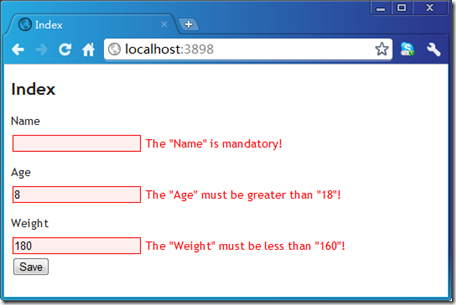让我们的ASP.NET MVC应用可以单独维护验证消息
在项目开发中,我们会使用到很多的描述性文字,比如验证消息、错误消息和确认消息等,让这些文本消息具有可维护性具有重要的意义。虽然我们可以将它们存储于资源文件中,并且ASP.NET的ValidationAttribute也对这种方式提供了原生的支持。但是资源文件的每个条目仅仅是简单的键-值对,只能存储消息的文本值而已,在我们的项目开发中使用的是专门的一个维护消息的组件。在这篇文章中将会通过扩展现有的ValidationAttribute特性让ASP.NET MVC应用可以使用我们的消息组件来获取验证消息。[源代码从这里下载]
一、ExtendedValidationAttribute
我们通过如下一个MessageManager来模拟我们独立的消息组件。简单起见,我们通过一个静态字典来维护所有的消息,Key和Value分别代表消息的Id和文本值。从如下的代码可以看出,消息文本可以支持{0}、{1}、…形式表示站位符。GetMessage方法根据指定的消息ID和替换站位符的对象数组格式化一个完成得消息文本。
1: public class MessageManager
2: {
3: static Dictionary<string, string> messages = new Dictionary<string, string>();
4: static MessageManager()
5: {
6: messages.Add("RequiredField", "The \"{0}\" is mandatory!");
7: messages.Add("GreaterThan", "The \"{0}\" must be greater than \"{1}\"!");
8: messages.Add("LessThan", "The \"{0}\" must be less than \"{1}\"!");
9: }
10: public string GetMessage(string messageId, params object[] args)
11: {
12: return string.Format(CultureInfo.CurrentCulture, messages[messageId], args);
13: }
14: public static MessageManager Current = new MessageManager();
15: }
通过直接继承ValidationAttribute的方式,我们定义了如下一个ExtendedValidationAttribute。我们仅仅定义了一个将消息ID和替换站位符的对象数组作为参数的构造函数,而该构造函数直接调用基类包含Func<string>参数的构造函数。至于用于获取验证消息Func<string>对象,则使用调用MessageManager的GetMessage方法来构建。
1: public class ExtendedValidationAttribute : ValidationAttribute
2: {
3: public ExtendedValidationAttribute(string messageId, params object[] args):
4: base(()=>MessageManager.Current.GetMessage(messageId,args))
5: {
6: }
7: }
二、扩展的RequiredAttribute和RangeAttribute
接下来我们来演示如何定义具体的ValidationAttribute,我们以用于验证必需字段/属性和值范围的RequiredAttribute和RangeAttribute为例。下面是我们自定义的RequiredAttribute和RangeAttribute,这里使用了一个比较讨巧的方式:直接调用System.ComponentModel.DataAnnotations.RequiredAttribute和System.ComponentModel.DataAnnotations.RangeAttribute的IsValid方法来实施验证。
1: [AttributeUsage(AttributeTargets.Parameter | AttributeTargets.Field | AttributeTargets.Property, AllowMultiple = false)]
2: public class RequiredAttribute : ExtendedValidationAttribute
3: {
4: public bool AllowEmptyStrings { get; set; }
5: public RequiredAttribute(string messageId, params object[] args) :
6: base(messageId,args)
7: {}
8: public override bool IsValid(object value)
9: {
10: return new System.ComponentModel.DataAnnotations.RequiredAttribute {AllowEmptyStrings = this.AllowEmptyStrings }.IsValid(value);
11: }
12: }
13:
14: [AttributeUsage(AttributeTargets.Parameter | AttributeTargets.Field | AttributeTargets.Property, AllowMultiple = false)]
15: public class RangeAttribute : ExtendedValidationAttribute
16: {
17: private System.ComponentModel.DataAnnotations.RangeAttribute innerRangeAttribute;
18:
19: public RangeAttribute(double minimum, double maximum, string messageId, params object[] args) :
20: base(messageId, args)
21: {
22: innerRangeAttribute = new System.ComponentModel.DataAnnotations.RangeAttribute(minimum, maximum);
23: }
24:
25: public RangeAttribute(int minimum, int maximum, string messageId, params object[] args):
26: base(messageId, args)
27: {
28: innerRangeAttribute = new System.ComponentModel.DataAnnotations.RangeAttribute(minimum, maximum);
29: }
30:
31: public RangeAttribute(Type type, string minimum, string maximum,string messageId, params object[] args) :
32: base(messageId, args)
33: {
34: innerRangeAttribute = new System.ComponentModel.DataAnnotations.RangeAttribute(type, minimum, maximum);
35: }
36:
37: public override bool IsValid(object value)
38: {
39: return innerRangeAttribute.IsValid(value);
40: }
41: }
三、实例演示
接下来我们来演示上面定义的两个验证特性在ASP.NET MVC项目中的应用。我们先定义如下一个实体类型Person,RequiredAttribute和RangeAttribute分别应用在表示名字、年龄和体重的Name、Age和Weight三个属性上。具体的验证规则是:名称是必需的,年龄必须大于18周岁而体重不得终于160斤。表示验证消息的ID和站位符对象数组作了相应的设置。
1: public class Person
2: {
3: [Required("RequiredField","Name")]
4: public string Name { get; set; }
5: [Range(18,int.MaxValue,"GreaterThan","Age",18)]
6: public int Age { get; set; }
7: [Range(int.MinValue, 160, "LessThan", "Weight", 160)]
8: public double Weight { get; set; }
9: }
在创建的ASP.NET MVC项目中添加下一个HomeController。
1: public class HomeController : Controller
2: {
3: public ActionResult Index()
4: {
5: return View(new Person { Name = "Zhan San", Age = 24, Weight = 120 });
6: }
7:
8: [HttpPost]
9: public ActionResult Index(Person person)
10: {
11: if (this.ModelState.IsValid)
12: {
13: throw new NotImplementedException();
14: }
15: return View();
16: }
17: }
Index.cshtml的内容如下所示,这是一个以Person对象作为Model的View。具体来说,这个View用于对Person对象三个属性的修改。
1: @model Artech.Web.Mvc.Extensions.Person
2:
3: @{
4: ViewBag.Title = "Index";
5: }
6:
7: <h2>Index</h2>
8: @using (Html.BeginForm())
9: {
10: @Html.EditorForModel()
11: <input type="submit" value="Save" />
12: }
运行我们的程序,如果输入的内容不符合定义在Person类型上的验证规则,相应的验证消息会被现实,而这些消息都是通过MessageManager来获取的。


 在项目开发中,我们会使用到很多的描述性文字,比如验证消息、错误消息和确认消息等,让这些文本消息具有可维护性具有重要的意义。在我们的项目开发中使用的是专门的一个维护消息的组件。在这篇文章中将会通过扩展现有的ValidationAttribute特性让ASP.NET MVC应用可以使用我们的消息组件来获取验证消息。
在项目开发中,我们会使用到很多的描述性文字,比如验证消息、错误消息和确认消息等,让这些文本消息具有可维护性具有重要的意义。在我们的项目开发中使用的是专门的一个维护消息的组件。在这篇文章中将会通过扩展现有的ValidationAttribute特性让ASP.NET MVC应用可以使用我们的消息组件来获取验证消息。


 蒋金楠,网名Artech,大内老A,知名IT博主, 微软多领域MVP,畅销IT图书作者。
蒋金楠,网名Artech,大内老A,知名IT博主, 微软多领域MVP,畅销IT图书作者。








【推荐】国内首个AI IDE,深度理解中文开发场景,立即下载体验Trae
【推荐】编程新体验,更懂你的AI,立即体验豆包MarsCode编程助手
【推荐】抖音旗下AI助手豆包,你的智能百科全书,全免费不限次数
【推荐】轻量又高性能的 SSH 工具 IShell:AI 加持,快人一步
· AI与.NET技术实操系列:向量存储与相似性搜索在 .NET 中的实现
· 基于Microsoft.Extensions.AI核心库实现RAG应用
· Linux系列:如何用heaptrack跟踪.NET程序的非托管内存泄露
· 开发者必知的日志记录最佳实践
· SQL Server 2025 AI相关能力初探
· winform 绘制太阳,地球,月球 运作规律
· 震惊!C++程序真的从main开始吗?99%的程序员都答错了
· AI与.NET技术实操系列(五):向量存储与相似性搜索在 .NET 中的实现
· 超详细:普通电脑也行Windows部署deepseek R1训练数据并当服务器共享给他人
· 【硬核科普】Trae如何「偷看」你的代码?零基础破解AI编程运行原理
2008-12-14 WCF中的Binding模型之六(完结篇):从绑定元素认识系统预定义绑定